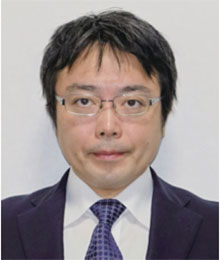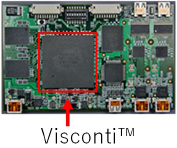Achievement Award
Development and Commercialization of Image Recognition Processor Visconti ™ Family



The Visconti™ family (Fig. 2) is the world's first image recognition processor that realizes road environment recognition by onboard camera (Fig. 1), assisting safety driving such as automatic emergency braking (AEB). The high-performance hardware [3, 4, 5, 6] enabled the processing of the algorithms for detecting obstacles and pedestrians, which achieve the world's highest level of accuracy in image recognition [1, 2] in real time with low power consumption which was a few tenths of that of a general CPU. The algorithms and hardware made it possible to realize a compact, failure-resistant, and low-cost camera-integrated system.
The Visconti™ family image recognition processor developed by the recipients incorporates advanced technologies in each generation. The first generation Visconti™ [3] released in 2003 runs an algorithm for detecting 3D obstacles with a single camera in real time [1], and the algorithm was recognized for its advanced achievement by one of the most important conferences on computer vision. Visconti™2 [4], released in 2011, was the world's first automotive LSI with many types (5 types) of dedicated image processing hardware. In particular, the HOG accelerator achieved the world's highest pedestrian detection performance by using the originally developed image feature descriptor CoHOG [2] that describes object shapes in the image. Many registered patents are owned by the recipients, including one which won the prize from the Japan Institute of Invention and Innovation. The latest Visconti™4 [5], released in 2016, has hardware for 3D measurement using time-series images and pedestrian detection using color images. Vehicles equipped the product received perfect scores of the automobile safety test (JNCAP: Japan New Car Assessment Program) conducted by MLIT (Ministry of Land, Infrastructure, Transport and Tourism), including AEB for pedestrians [7]. The score has been perfect from 2018 to the present, proving its superiority. The next generation Visconti™5 [6] will be equipped with deep neural network inference hardware as a part of an image recognition AI processor, and is expected to be deployed in industrial fields such as AGVs (Automated Guided Vehicles) and surveillance cameras, as well as automated driving and safety driving assistance.
In terms of practical use, domestic automakers have recognized the efficiency of the product and it has been installed in many vehicles. In the field of LSIs for onboard cameras, the ViscontiTM family is ranked 4th in the world, the highest share among Japanese manufacturers. AEB is becoming mandatory from 2021 in Japan and Europe, and the growth rate of the market has been predicted to be over 20% [8].
The image recognition algorithms and the Visconti™ family developed by the recipients have made a significant contribution to the safety of automobile traffic, and papers on the technologies have been accepted for major international conferences and have won awards. In practical use, it has been installed in many automobiles and is contributing to automobile safety. The achievements of the recipients are truly remarkable and worthy of this IEICE achievement award.


References
- R. Okada, et. al., “Obstacle Detection Using Projective Invariant and Vanishing Lines,” IEEE ICCV, pp. 330-337, 2003.
- T. Watanabe, et. al., “Co-occurrence Histograms of Oriented Gradients for Human Detection,” IPSJ Trans. on CVA, Vol. 2, pp.39-47, 2010.
- J. Tanabe, et. al., “Visconti: Multi-VLIW Image Recognition Processor Based on Configurable Processor,” IEEE CICC, pp.185-188, 2003.
- Y. Tanabe, et. al., “A 464GOPS 620GOPS/W Heterogeneous Multi-Core SoC for Image-Recognition Applications,” IEEE ISSCC, pp.222-223, 2012.
- J. Tanabe, et. al., “A 1.9TOPS and 665GOPS/W Heterogeneous Multi-Core SoC with Color-based Object Classification Accelerators for Image Recognition Applications,” IEEE ISSCC, pp. 1-3, 2015.
- Y. Yamada, et. al., “A 20.5TOPS and 217.3GOPS/mm2 Multicore SoC with DNN Accelerator and Image Signal Processor Complying with ISO26262 for Automotive Applications,” IEEE ISSCC, pp. 132-134, 2019.
- https://toshiba.semicon-storage.com/jp/company/news/news-topics/2020/06/automotive-20200612-1.html
- https://www.alliedmarketresearch.com/adas-market